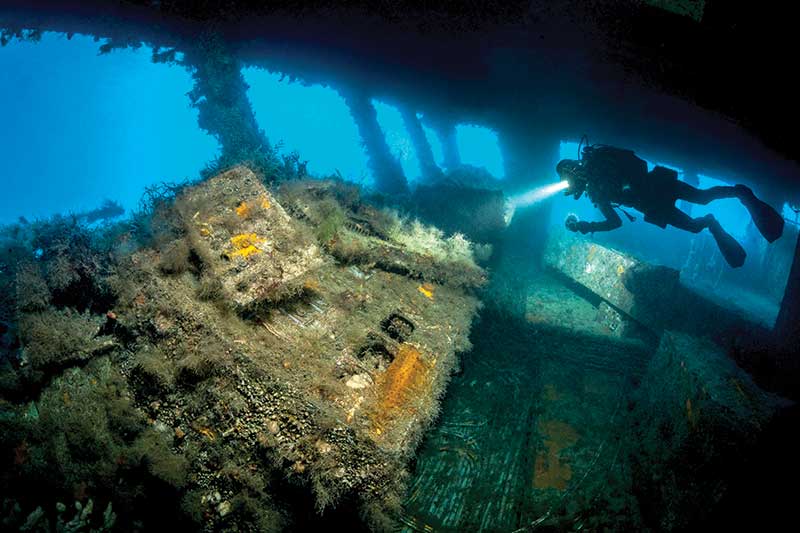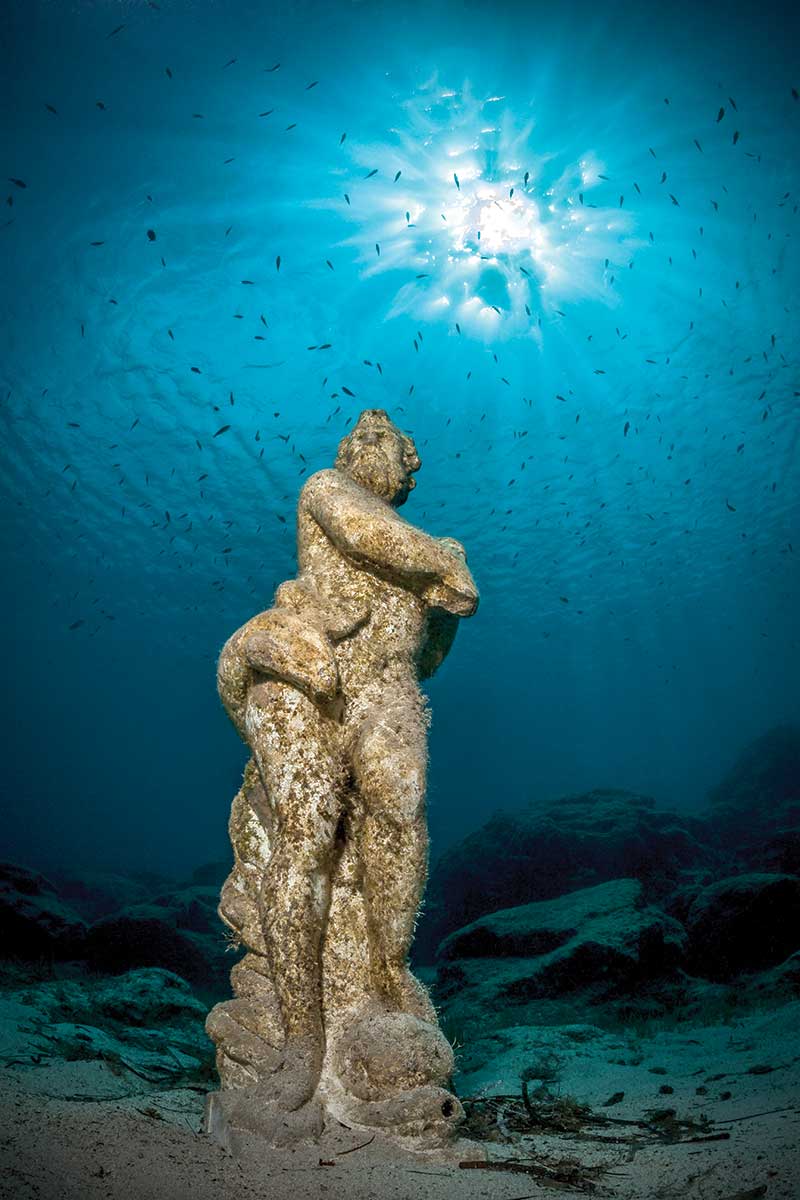Discovering The Art of Zen In Cyprus
The gargantuan wreck of cargo ship Zenobia is regarded as one of the world’s best dives, but it doesn’t come without its hazards
Words and Photography by Tobias Friedrich

The Zenobia is considered one of the best wrecks in the world. And rightly so. You could make a hundred dives on this 555-foot (170m) ferry, which sank with its entire cargo off the coast of the island nation of Cyprus, and it still wouldn’t get boring. ‘The Zen’ is clearly the diving highlight of the island, but that says something about the special quality of the wreck, not the quality of the other dive sites. The Zenobia is exceptional. It simply outshines them.
“On good days, you can see the wreck from the surface,” gushes Martin Richter, who lives in Cyprus and often uses his days off to explore the wreck over and over again. “Unfortunately, visibility is not so good today, and the strong winds of recent days have worsened visibility a bit,” Richter continues. Nevertheless, shortly after the descent, the first contours of the wreck emerge, whose shallowest point begins at a depth of approximately 55 feet (17m). The diver’s first view of the wreck falls on the huge sidewall of the wreck, where the anchor ropes for the dive boats are moored. The ferry, which was on its maiden voyage from Sweden to Syria when it went down in 1980, lies portside-down, directly off of the island of Cyprus at a depth of 137 feet (42m). But how did it come by this misfortune? “The Zenobia arrived at the port of Larnanca with a list of 32 degrees,” explains Valantis, the Cypriot diving instructor who is passionate about the wreck. “Apparently the bilge pumps were not properly installed or switched, so the ship pumped in more and more water instead of letting it out,” he says. The huge ferry was about to sink in the harbour, which did not suit the local harbour master. So the Zenobia was towed about two nautical miles (3.7km) off the coast, where it finally sank and remains today. With about a hundred trucks and a car (the captain’s Lada), it is a huge underwater playground for divers. Valantis, who made about 70 dives at Zenobia last year, says, “Even with supposedly identical dives, I keep discovering new things – the Zenobia just doesn’t get boring.”

Charmed
But what exactly is the charm of the Zen? Unlike other wrecks that have been sunk as artificial reefs for divers, the Zenobia went down with all its cargo. Virtually nothing could be saved, and all of the valuable cargo sank with her into the depths. In the cafeteria there’s a beer dispenser, which is overgrown with algae but still looks like it recently tapped its last keg. The canteen carpet still retains its red colour, although it fades a little more year after year. Everything on the cargo decks, including the hundred or so trucks, has slid to the starboard side into a giant rubble heap. Between huge double axles, long wooden planks— probably the freight from some of the trucks—tower up like crooked teeth. One of the trucks had a load of thousands of small plastic doodads filled with air, which now decorate the ceiling of one of the cargo decks. Every now and then, amongst the chaos, you come across a backpack that apparently could not be salvaged in time —a reminder of the gravity of the accident, which fortunately did not cost any human lives. This makes the Zenobia, in contrast to the frequently-discussed penetration of the Salem
Express in Egypt, morally and ethically harmless. Strictly speaking, that is—since the Zenobia has claimed lives, but only subsequent to the sinking.
Despite the spirit of discovery and the beauty of chaos, divers must not forget the dangers of a dive on Zenobia. There are lots of loose cables and ropes scattered all over the wreck and you have to pay attention if you do not want to become entangled. You also have to be well versed in a ‘proper’ penetration, which is why a guided dive is basically indispensable if you want to dive deep into the wreckage. At no time should you take your eyes off your air or your dive computer: the most interesting places inside the wreck lie between 80 and 115 feet (25 and 35m) deep and will take a scuba diver on air to the limit. A nitrox mix is a better choice; better still with double tanks or one or more stages. Not without reason is the Zen a favourite with tech divers—it’s interesting and challenging. This is not a place to overestimate your abilities or explore unfamiliar areas on your own. The Zenobia has already cost the lives of divers who went beyond their capabilities, underestimated the wreck, or could not solve unexpected problems. Despite all the dangers and warnings, the dives at the Zenobia are unforgettable and definitely addictive, especially for photographers; there are endless subjects available, although the time to photograph them is limited by the depth.

Not the only sight
The Zenobia is the diving highlight of Cyprus. The other dive sites are not bad, but they can’t compete with that excellent wreck. That said, if you want to see more than just rusting steel on your dive trip, there are several other good dive sites on Cyprus, such as Cape Greco, which is located in the very east of the island. From a bluff, you climb carefully down over the rocks and into the crystal-clear water of the coast. The topography continues underwater, with abundant rocks covered with a fine layer of light-coloured sand that has accumulated between them to form bright areas where the vigorous green of the seagrass meadows interrupts the monochromatic landscape. The highlight of this dive site is a series of several shallow caves that can be dived easily, although some caution is appropriate due to the low ceiling height. Since the passages are only a few yards/metres long and the whole dive site is not deeper than 40 feet (12m), this is also an ideal playground for beginners and children.
A little further north is Green Bay, with a slightly easier access via a shallow sandy beach. The topography is similar to Cape Greco with the difference that, instead of caves, here there is a small underwater statue park to admire. The statues, which consist of replicas of various gods such as Neptune, were provided by a Russian dive center to make the place even more interesting for the divers.

For those who can’t get enough of wrecks, you can dive two small wrecks in Limassol, which is about an hour’s drive west of Larnaca. The two smaller vessels were sunk by the Cyprus Tourist Office and the Cyprus Dive Center organization, not only for divers but also to protect the local fish population. Unlike the Zenobia, these artificial reefs are free of any entanglement dangers such as cables or ropes. The Lady
Thetis is a former fishing boat whose helm provides divers a great photo opportunity and several large groupers a beautiful home. The other wreck, the Constandis, is a former excursion boat; the engine room can be easily penetrated, as well as the intermediate deck with a large staircase in the middle. On the sundeck there are several built-in tables and stools, on which probably hundreds of rock-paper-scissor-games have been played by divers so far.
Diving the wreck of the Zenobia is an absolute must if you are in diving in Cyprus. It’s an exceptional deep wreck dive, one of the world’s best, and an experience you’ll never forget. Scale and complexity of the wreck means there are many different dives to enjoy. You could dive on this exceptional wreck every day and never tire of it.
Good to Know:
Getting there: Most flights arrive at Larnaca International Airport from Athens or other European city. Canadians, most Americans, and EU passport holders can visit Greece without a visa.
When to go: March to November. August can be very hot – remember, Cyprus is right off the Middle East!
Stay at: Club Aldiana Cyprus
Dive Operators: For a list visit www.cyprusdiving.org.cy
Diving Details: The Zenobia is accessible by boat 0.9 miles (1.4km) from Larnaca. The wreck lies on bottom at 137 feet (42m); top of the wreck is in 52 feet (16m). Minimum of Advanced Open Water certs required.
Exposure protection: Water temps range from 60-80°F (16-27°C) so anything from bathing suit to a 3mm wetsuit depening on your tolerance.
Visibility: Little current with visibility averaging 65-115+ feet (20-35+m), although winter storms can drop vis to a few feet.
Leave a Comment







